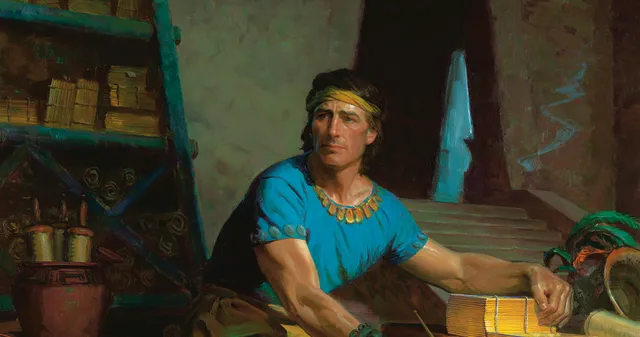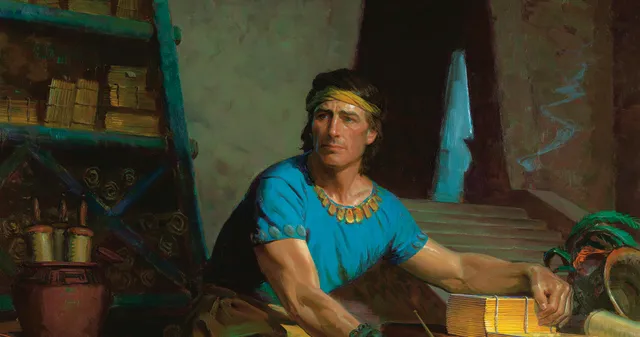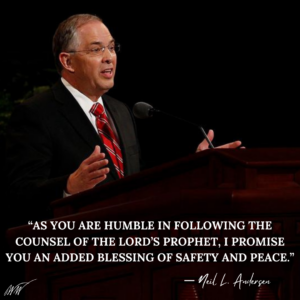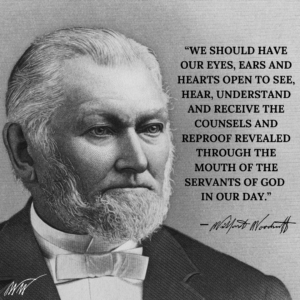
FAIR is a non-profit organization dedicated to providing well-documented answers to criticisms of the doctrine, practice, and history of The Church of Jesus Christ of Latter-day Saints.

“We Rejoice in Christ”
Book of Mormon Chapters: Mormon 1–6
Historical Context: Mormon takes on the mantle of leadership as a young man, witnessing the increasing wickedness of his people and their ultimate destruction.
This passage shows the difference between godly and worldly sorrow through the example of Mormon’s people. While godly sorrow prompts self-reflection, humility, and repentance, leading us to Christ, worldly sorrow centers on negative self-focus and can even cause us to resist divine influence. This sorrow might lead to frustration with God rather than growth. One approach to fostering godly sorrow is to focus on humility and recognize personal accountability in a spirit of faith. We can look to 2 Corinthians 7:8–11, which highlights that godly sorrow “worketh repentance to salvation,” while worldly sorrow “worketh death.” By turning to Christ in humility, our sorrow transforms into a vehicle for lasting change, as taught by Michelle D. Craig in “Divine Discontent.” In doing so, we align with God’s purposes for us and find hope rather than despair in our moments of sorrow.
How could there be two different locations referred to as “Cumorah”? Many assume that the New York hill where Joseph Smith retrieved the golden plates is the same Cumorah where Mormon hid all the Nephite records, yet some scholars argue that these are distinct locations. How can these two ideas be reconciled?
Response:
The idea of “two Cumorahs” suggests that the hill in New York—where Joseph Smith found the plates—was named Cumorah later, possibly by Moroni himself, in memory of the original hill where Mormon deposited the Nephite records in preparation for their final battle. The Book of Mormon narrative places the final battles in a land with geographical features different from those near the New York hill. The Book of Ether also describes Omer traveling past the hill Shim and a battlefield where the Nephites were destroyed, suggesting that these sites were not thousands of miles from each other, which aligns more with a Middle American setting than with New York.
Sidney B. Sperry and other scholars highlight that the geography surrounding the hill where the Nephites were destroyed is “in a land of many waters, rivers, and fountains” (Mormon 6:4), which matches descriptions of Central America’s landscape. This historical evidence suggests that while the hill in New York became associated with Cumorah due to Joseph’s retrieval of the plates, the actual “Cumorah” of Nephite history may have been in a different location, closer to the primary settings of Nephite and Jaredite civilizations.
Resource:
For an in-depth examination of this topic, see Sidney B. Sperry’s article, “Were There Two Cumorahs?” in the Journal of Book of Mormon Studies, which details scriptural and historical evidence supporting the Middle American location hypothesis. The article is available at BYU ScholarsArchive.
Challenge:
Critics argue that Joseph Smith may have taken the names “Cumorah” and “Moroni” from the Comoros Islands, as pirates, like Captain Kidd, were known to operate nearby. Some say Joseph, influenced by Captain Kidd stories, could have seen the names on maps or in tales of the time. Does this argument hold up?
Response:
The claim that Joseph derived “Cumorah” and “Moroni” from Captain Kidd stories or maps of the Comoros Islands is an argument from silence and lacks supporting evidence. Records of Captain Kidd’s tales do not mention the names “Cumorah” or “Moroni.” Even in the 1724 book A General History of the Robberies and Murders of the Most Notorious Pirates by Charles Johnson, a major influence on pirate lore, “Comoros” and “Moroni” are absent. Although the Comoros Islands appear on some maps, no documented link shows that Joseph saw these maps, nor do records indicate he had access to such resources.
Additionally, the settlement named “Moroni” did not become the capital of the Comoros until 1876, well after Joseph’s death and the publication of the Book of Mormon in 1830. Moreover, the Book of Mormon names “Cumorah” and “Moroni” align with other ancient-sounding names within the text, suggesting a linguistic consistency rather than a random borrowing from obscure, unrelated geographic sources.
Resource:
For an in-depth response to this issue, including insights on the lack of historical evidence linking Joseph Smith to pirate lore and maps of the Comoros, see the FAIR article “Joseph Smith, Captain Kidd, and the Comoro Archipelago”. This source explains why such claims rely on speculation without historical basis.
If you have questions on this week’s reading, please email your questions to us here.
There are many principles to find in Mormon 1-6. Some are highlighted in the lesson outline, but you will find others. Let Heavenly Father, through His Spirit, teach you what you need right now.
“How important is repentance? Alma taught that we should “preach nothing save it were repentance and faith on the Lord.”7 Repentance is required of every accountable person who desires eternal glory.8 There are no exceptions. In a revelation to the Prophet Joseph Smith, the Lord chastised early Church leaders for not teaching the gospel to their children.9 Repenting is the key to progress. Pure faith keeps us moving forward on the covenant path.
Please do not fear or delay repenting. Satan delights in your misery. Cut it short. Cast his influence out of your life! Start today to experience the joy of putting off the natural man.10 The Savior loves us always but especially when we repent. He promised that though “the mountains shall depart, and the hills be removed … my kindness shall not depart from thee.”11
If you feel you have strayed off the covenant path too far or too long and have no way to return, that simply is not true.12 Please contact your bishop or branch president. He is the Lord’s agent and will help you experience the joy and relief of repenting.
Now, a caution: Returning to the covenant path does not mean that life will be easy. This path is rigorous and at times will feel like a steep climb.13 This ascent, however, is designed to test and teach us, refine our natures, and help us to become saints. It is the only path that leads to exaltation. One prophet14 described the “blessed and happy state of those that keep the commandments of God. For behold, they are blessed in all things, both temporal and spiritual; and if they hold out faithful to the end they are received into heaven … [and] dwell with God in a state of never-ending happiness.”15
Walking the covenant path, coupled with daily repentance, fuels positive spiritual momentum.” President Russell M. Nelson, The Power of Spiritual Momentum
1-5: Ammaron (see 4 Nephi 34-37) tells a young Moroni where he has hidden the Nephite records and instructs him to retrieve them in approximately 14 years.
6-12: Mormon and his father travel to Zarahemla. The Nephite civilization had expanded such that the “whole face of the land had become covered with buildings.” Wars between the Nephites and Lamanites continue.
13-19: The Nephites have completely hardened their hearts. Though Mormon has remained faithful, he is forbidden to preach due to the Nephites’ rejection of God.
1-9: Though he is only 16, Mormon is chosen to lead the Nephite army. Fighting continues, with the Lamanites forcing the Nephites to retreat. They regroup in the land of David, finally gathering enough force to withstand the Lamanite army.
10-16: Mormon hopes that the disastrous circumstances facing the Nephites will compel them to repent, but unfortunately it has the opposite effect. They curse God. Many Nephites are killed and they are forced to retreat again.
17-19: Mormon details his updating of various Nephite records.
20-29: After several years of retreating from the Lamanites, Mormon inspires the Nephite army to fight valiantly. They are victorious, reclaiming much of their land and cities. A truce is declared.
1-8: During the ensuing 10 years of peace Mormon tries to call the Nephites to repentance, but to no avail. The years of peace end and the Lamanite army twice tries unsuccessfully to conquer the Nephite strongholds.
9-16: Because of their victory over the Lamanites, the Nephites boast of their own strength and blaspheme God and their sacred heritage. Disgusted by what they have become, Mormon refuses to lead their armies.
17-22: Mormon focuses his efforts on his record, hoping to communicate to both the Gentiles and the House of Israel that they will one day stand before God to be judged for their works and their faith in Jesus Christ.
1-15: The Nephite/Lamanite wars continue with both armies experiencing occasional victories. However, the end result was great loss of life, depravity, and blood and carnage on both sides.
16-23: However, in approximately the 375th year the Lamanites gain an advantage from which the Nephites never recover. Mormon, recognizing their eventual defeat, retrieves all the plates stored by Ammoron in the hill Shim.
1-7: Mormon agrees to again lead the Nephite army, though without hope of eventual victory. While they are able to withstand several Lamanite advances, within five years they are forced to retreat. Those who are healthy and swift escape. Those who are overtaken by the Lamanites are slaughtered.
8-13: It saddens Mormon to record on the plates the devastation he is witnessing, but he knows that in the latter days a remnant of the house of Lehi, along with the Gentiles, will come in contact with this history. They will profit from the sad history of the Nephites and the Lamanites.
14-24: In that day, the Gentiles will discover that the remnants of Lehi’s family have been scattered and have lost all contact with the Spirit. The Gentiles will teach them the gospel of Jesus Christ and help them to regain their promised covenant blessings.
1-6: All the Nephites gather in one location, around the hill Cumorah, to prepare for a final battle with the Lamanites. Mormon hides the Nephite records so they will not be destroyed.
7-15: The last battle kills all but a few dozen Nephites, with Mormon and his son Moroni both surviving.
16-22: Mormon grieves for the Nephite nation, destroyed because they “departed from the ways of the Lord. . . who stood with open arms to receive” them. Their outcome could have and should have been entirely different.

…Despite all the wickedness in our world today, we have many tools to help us stay on the straight and narrow path…
 In Mormon chapters 1–6, we read about the complete disintegration of civilization due to the people’s wickedness and their rejection of God’s teachings. Despite observing many horrible things, the prophet Mormon remained faithful to God. In Mormon 3:22 he said, “And I would that I could persuade all ye ends of the earth to repent and prepare to stand before the judgment-seat of Christ.” He knew that even though his people would not listen to his warnings and would not repent, he had a meaningful purpose to fulfill.
In Mormon chapters 1–6, we read about the complete disintegration of civilization due to the people’s wickedness and their rejection of God’s teachings. Despite observing many horrible things, the prophet Mormon remained faithful to God. In Mormon 3:22 he said, “And I would that I could persuade all ye ends of the earth to repent and prepare to stand before the judgment-seat of Christ.” He knew that even though his people would not listen to his warnings and would not repent, he had a meaningful purpose to fulfill.
Mormon warned us of what can happen when we reject God’s teachings and fall into wickedness. What he witnessed is similar to the things we see in our world today. We are surrounded by wars, violence, and immorality. I am grateful for prophets of old, like Mormon, who were inspired to write counsel in the Book of Mormon that pertains to us today. I am also grateful for our modern prophet, President Russell M. Nelson, who guides and directs us in the face of the increasing wickedness of the world around us.
President Wilford Woodruff wrote, “We should have our eyes, ears and hearts open to see, hear, understand and receive the counsels and reproof revealed through the mouth of the servants of God in our day.” 
Despite all the wickedness in our world today, we have many tools to help us stay on the straight and narrow path: We have the Book of Mormon to read and learn from, which was written for our day. We have modern-day prophets like Wilford Woodruff and Russell M. Nelson to lead and guide us. And we have the Holy Ghost to direct our daily lives.
When we study the Book of Mormon, heed the words of modern-day prophets, and utilize the gift of the Holy Ghost, we can be protected from wickedness and remain on the covenant path.
[1] Discourse by Wilford Woodruff, July 19, 1868, p. 6, The Wilford Woodruff Papers, wilfordwoodruffpapers.org/discourse/1868-07-19. Punctuation standardized.
 Maddie is a graduate of Brigham Young University and holds a bachelor’s degree in public relations. She currently lives in Kansas City. She enjoys cooking, traveling, reading, and spending time with friends and family. Maddie has always loved learning about Church history and is greatly inspired by the words of Wilford Woodruff. She is passionate about sharing those words with everyone and is grateful to be part of such an incredible project.
Maddie is a graduate of Brigham Young University and holds a bachelor’s degree in public relations. She currently lives in Kansas City. She enjoys cooking, traveling, reading, and spending time with friends and family. Maddie has always loved learning about Church history and is greatly inspired by the words of Wilford Woodruff. She is passionate about sharing those words with everyone and is grateful to be part of such an incredible project.


FAIR is a non-profit organization dedicated to providing well-documented answers to criticisms of the doctrine, practice, and history of The Church of Jesus Christ of Latter-day Saints.
We are a volunteer organization. We invite you to give back.
Donate Now